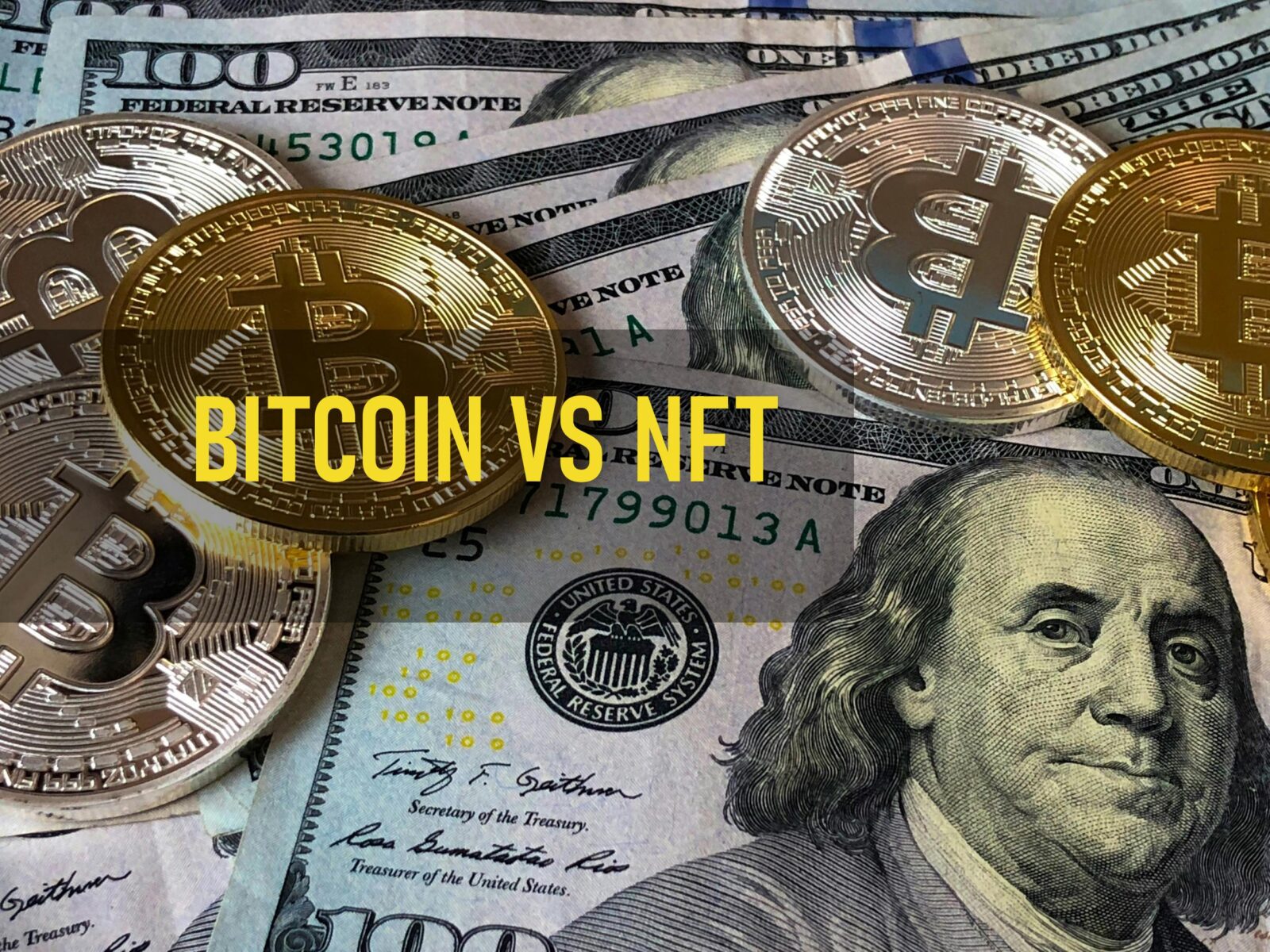With the rise of cryptocurrency and blockchain technology, Bitcoin and NFTs (Non-Fungible Tokens) have become two of the most prominent digital assets. However, despite both being built on blockchain technology, they serve vastly different purposes and have unique characteristics. Bitcoin is often referred to as “digital gold” and functions as a decentralized currency, while NFTs represent unique digital assets, such as art, music, and virtual real estate.
In this article, we’ll compare Bitcoin and NFTs, explore their differences, and discuss their respective roles in the digital economy.
What is Bitcoin?
Bitcoin, launched in 2009 by the pseudonymous creator Satoshi Nakamoto, is a decentralized digital currency that operates on a peer-to-peer network. It allows users to send and receive payments without the need for intermediaries, such as banks or governments. Bitcoin transactions are recorded on a public blockchain, and the network is secured by a proof-of-work consensus mechanism, where miners validate transactions.
Key Features of Bitcoin:
- Decentralized: No single entity controls Bitcoin, making it immune to government interference.
- Limited Supply: There will only ever be 21 million Bitcoins, making it a deflationary asset.
- Store of Value: Bitcoin is increasingly seen as “digital gold,” used as a hedge against inflation and economic instability.
- Medium of Exchange: While Bitcoin can be used for transactions, its role as a store of value has become more prominent in recent years.
- Fungibility: All Bitcoins are interchangeable and hold the same value, regardless of their history.
What are NFTs?
NFTs (Non-Fungible Tokens) are digital assets that represent ownership of a unique item or piece of content, such as digital art, music, videos, collectibles, and even virtual real estate. Unlike Bitcoin, which is fungible (each Bitcoin is the same as another), NFTs are non-fungible, meaning that each one is unique and cannot be exchanged on a one-to-one basis.
NFTs are typically built on blockchain platforms such as Ethereum and use smart contracts to establish ownership, transfer rights, and ensure the uniqueness of the asset.
Key Features of NFTs:
- Unique Assets: Each NFT represents something unique, such as artwork or a digital collectible.
- Ownership Proof: NFTs serve as a certificate of ownership that is recorded on the blockchain.
- Non-Fungibility: Unlike Bitcoin, NFTs are not interchangeable—each NFT has a distinct value based on its uniqueness and market demand.
- Smart Contracts: NFTs use smart contracts to automatically execute sales and transfers, ensuring that creators and owners retain control over their assets.
- Digital Collectibles: NFTs are often used in industries such as art, gaming, and entertainment to tokenize assets and create new markets for digital goods.
Bitcoin vs. NFTs: Key Differences
| Feature | Bitcoin | NFTs |
|---|---|---|
| Purpose | Decentralized digital currency | Digital asset ownership (art, collectibles, etc.) |
| Fungibility | Fungible (each Bitcoin is identical) | Non-fungible (each NFT is unique) |
| Supply | Limited to 21 million coins | Unlimited; each NFT is unique |
| Value Determination | Based on market demand and supply | Determined by rarity, creator, and market demand |
| Use Case | Store of value, medium of exchange | Proof of ownership, digital art, collectibles |
| Blockchain | Operates on Bitcoin blockchain | Typically operates on Ethereum or similar platforms |
| Security | Secured by proof-of-work consensus | Secured by smart contracts and blockchain technology |
| Investment Focus | Long-term value storage, inflation hedge | Speculative investments in digital goods |
| Transferability | Easily transferable between users | Transferable but specific to each unique asset |
| Volatility | High volatility, but stabilizing over time | Extremely volatile, driven by speculative demand |
1. Fungibility vs. Non-Fungibility
- Bitcoin: As a fungible asset, each Bitcoin is identical to another. One Bitcoin holds the same value as any other, making it interchangeable. This fungibility is essential for Bitcoin’s role as a currency and store of value.
- NFTs: NFTs are non-fungible, meaning that each one is unique and has a different value. For example, an NFT representing a piece of digital art from a well-known artist will hold a different value compared to another NFT representing a different asset. This uniqueness is crucial for NFTs’ role in representing ownership of digital assets like art, collectibles, and virtual items.
2. Purpose and Use Cases
- Bitcoin: Bitcoin’s primary use case is as a digital currency and store of value. It is increasingly being used by institutions, investors, and individuals as a hedge against inflation and economic instability. While Bitcoin can also be used for transactions, its limited supply and growing value have led many to treat it as “digital gold.”
- NFTs: NFTs serve a different purpose, acting as a certificate of ownership for digital assets. NFTs are used in industries such as art, gaming, and entertainment to create unique, verifiable ownership of digital goods. This has opened up new possibilities for creators, artists, and collectors to monetize and trade digital content in a way that was previously impossible.
3. Supply and Scarcity
- Bitcoin: Bitcoin’s total supply is capped at 21 million coins, ensuring that it remains a scarce asset. This scarcity drives its value, especially as demand for Bitcoin continues to grow.
- NFTs: NFTs, on the other hand, do not have a supply cap. Each NFT is unique, and there can be an unlimited number of NFTs created. The value of an NFT is based on its uniqueness and the reputation of the creator, rather than an overall supply cap.
4. Value Determination
- Bitcoin: Bitcoin’s value is determined by market demand and supply. Its price is influenced by factors such as institutional adoption, macroeconomic trends, and global market sentiment.
- NFTs: The value of an NFT is more subjective and is driven by rarity, creator reputation, and collector demand. For instance, an NFT from a famous artist or a rare collectible may sell for millions, while others might have little to no market value.
5. Volatility
- Bitcoin: Bitcoin is known for its price volatility, with sharp swings in price often driven by market speculation, regulatory developments, and macroeconomic factors. However, over time, Bitcoin’s value has generally trended upward as adoption has increased.
- NFTs: NFTs are even more volatile than Bitcoin, with prices largely driven by speculative demand. An NFT may experience a rapid increase in value during periods of hype but can also lose value just as quickly if the market cools down or if interest in the asset diminishes.
Which is a Better Investment: Bitcoin or NFTs?
Bitcoin as an Investment:
- Long-Term Store of Value: Bitcoin’s limited supply and increasing adoption by institutions make it a reliable store of value, often compared to digital gold.
- Lower Speculative Risk: While Bitcoin is still volatile, it has a well-established market and growing legitimacy as an investment asset.
- Widespread Use Case: Bitcoin’s use as a medium of exchange and hedge against inflation makes it more than just a speculative asset.
NFTs as an Investment:
- High Potential for Short-Term Gains: NFTs have seen enormous price growth in certain markets, especially in the art and collectibles space, making them attractive to speculators.
- Creative Ownership: NFTs offer unique opportunities for creators to monetize digital assets and for collectors to own exclusive pieces of art or virtual real estate.
- Higher Speculative Risk: The value of NFTs is highly speculative, and their prices can fluctuate significantly based on market trends and hype.
Bitcoin vs. NFTs: Conclusion
While both Bitcoin and NFTs represent important innovations in the blockchain space, they serve very different purposes. Bitcoin is primarily a decentralized currency and a store of value, designed to offer a digital alternative to fiat money and a hedge against inflation. Its fungibility, limited supply, and increasing adoption make it a reliable asset for long-term investors.
NFTs, on the other hand, are digital assets that represent ownership of unique items such as art, collectibles, and virtual goods. While NFTs open up exciting possibilities for creators and collectors, they are far more speculative and volatile than Bitcoin. NFTs may offer high returns in the short term, but they come with much higher risks.
For those seeking a long-term, stable investment, Bitcoin is likely the better choice. However, for those interested in digital art, collectibles, or high-risk speculation, NFTs may offer exciting opportunities, but with the potential for significant losses. Ultimately, the decision between Bitcoin and NFTs depends on your investment goals, risk tolerance, and interest in the digital economy.






Leave a Reply